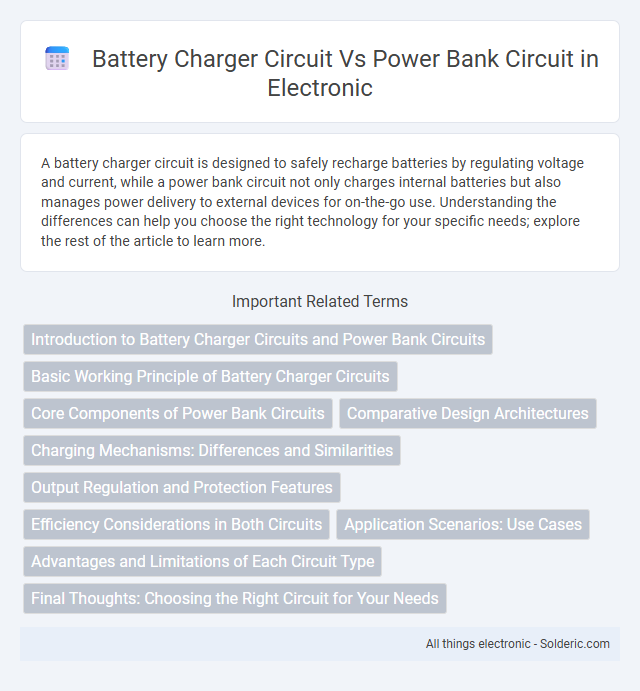A battery charger circuit is designed to safely recharge batteries by regulating voltage and current, while a power bank circuit not only charges internal batteries but also manages power delivery to external devices for on-the-go use. Understanding the differences can help you choose the right technology for your specific needs; explore the rest of the article to learn more.
Comparison Table
| Feature | Battery Charger Circuit | Power Bank Circuit |
|---|---|---|
| Primary Function | Charges batteries by regulating voltage and current | Stores electrical energy and supplies power to external devices |
| Components | Rectifier, voltage regulator, current limiter, charge controller | Rechargeable battery, boost converter, charging controller, USB ports |
| Energy Storage | No energy storage; only facilitates charging | Includes battery for energy storage |
| Output | Supplies regulated voltage/current to battery only | Provides regulated voltage via USB to charge devices |
| Portability | Typically fixed or stationary | Portable and designed for mobile use |
| Use Case | Battery maintenance and charging in controlled environments | On-the-go power supply for smartphones, tablets, and gadgets |
| Voltage Regulation | Strictly controlled per battery specifications | Includes step-up/down converters for consistent output |
| Safety Features | Overcharge protection, temperature control | Short circuit protection, over-discharge, and thermal management |
Introduction to Battery Charger Circuits and Power Bank Circuits
Battery charger circuits regulate the voltage and current supplied to rechargeable batteries, ensuring safe and efficient charging by preventing overcharging and damage. Power bank circuits incorporate battery charger functionalities along with power management components such as boost converters, USB interfaces, and protection mechanisms to store and deliver portable power for electronic devices. Both circuits prioritize battery health, but power bank circuits emphasize portability, energy storage, and multi-device compatibility.
Basic Working Principle of Battery Charger Circuits
Battery charger circuits regulate voltage and current to safely recharge batteries by controlling the electrical energy flow, preventing overcharging and damage. These circuits typically use feedback mechanisms and components like transformers, rectifiers, and voltage regulators to maintain a stable output. Understanding your battery charger's basic working principle helps optimize charging efficiency and prolong battery lifespan.
Core Components of Power Bank Circuits
Power bank circuits primarily consist of lithium-ion or lithium-polymer battery cells, a battery management system (BMS) for safety and efficiency, and a DC-DC converter to regulate output voltage. Core components also include a microcontroller unit (MCU) to monitor charging status and protect against overcharging, short circuits, and overheating. These elements work together to ensure stable energy storage, controlled charging, and reliable power delivery to connected devices.
Comparative Design Architectures
Battery charger circuits typically feature a direct interface with a power supply, employing regulated voltage and current control modules to safely charge batteries, while power bank circuits integrate additional components such as boost converters and battery management systems for portable energy storage and output. The design architecture of a battery charger emphasizes efficient energy transfer and thermal management to enhance battery lifespan, whereas a power bank circuit balances compact size with multifunctional protection features like overcharge, short circuit, and temperature monitoring. Your choice between these circuits depends on whether the priority is stationary charging efficiency or mobile power delivery with integrated control systems.
Charging Mechanisms: Differences and Similarities
Battery charger circuits regulate current and voltage to safely recharge batteries through direct electrical input, optimizing efficiency for specific battery chemistries like lithium-ion or NiMH. Power bank circuits integrate battery charging with energy storage and output management, featuring components for both charging the internal battery and converting stored energy to USB-compatible power for external devices. Your choice depends on whether you need straightforward battery recharging or a portable power solution combining charging and power delivery functions.
Output Regulation and Protection Features
Battery charger circuits typically include precise output regulation mechanisms using voltage and current control to safely charge batteries, preventing overcharging and thermal runaway. Power bank circuits integrate advanced protection features such as over-discharge, short-circuit, and overcurrent protection, ensuring device safety and battery longevity during power delivery. Both circuits utilize feedback loops and integrated protection ICs to maintain stable output voltages tailored to battery chemistry and load requirements.
Efficiency Considerations in Both Circuits
Battery charger circuits typically optimize efficiency by regulating voltage and current to prevent overcharging and heat loss, often achieving 85-95% efficiency depending on the technology used. Power bank circuits prioritize energy storage and delivery efficiency, incorporating high-efficiency DC-DC converters to maximize the transfer from battery cells to your device, commonly reaching 80-90% efficiency under typical loads. Understanding the efficiency considerations helps you choose the right solution for balanced power management and optimal energy use.
Application Scenarios: Use Cases
Battery charger circuits are primarily used in fixed applications such as charging lithium-ion or lead-acid batteries in devices like smartphones, laptops, and electric vehicles, ensuring consistent and regulated power delivery. Power bank circuits are designed for portable energy storage, enabling on-the-go charging of multiple devices including smartphones, tablets, and wearable electronics through USB outputs. Both circuits optimize energy management, but battery chargers focus on direct battery replenishment in stationary environments, while power bank circuits prioritize portability and multi-device compatibility.
Advantages and Limitations of Each Circuit Type
Battery charger circuits offer efficient, direct charging with precise current and voltage regulation, ensuring battery safety and longevity. Power bank circuits integrate battery charging with portable power delivery, providing convenience and mobility but often sacrificing charging speed and requiring complex management systems. Each circuit type balances trade-offs between charging efficiency, portability, and circuit complexity depending on the application requirements.
Final Thoughts: Choosing the Right Circuit for Your Needs
Battery charger circuits are ideal for stationary setups requiring efficient charging and battery maintenance, while power bank circuits prioritize portability and integrated power management for on-the-go charging. Consider factors such as battery type, charging speed, voltage regulation, and intended use to determine the optimal circuit. Selecting the right circuit enhances battery lifespan and ensures reliable power supply tailored to your specific application.
battery charger circuit vs power bank circuit Infographic

 solderic.com
solderic.com